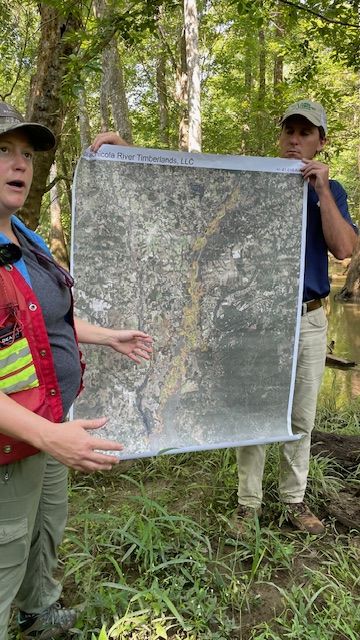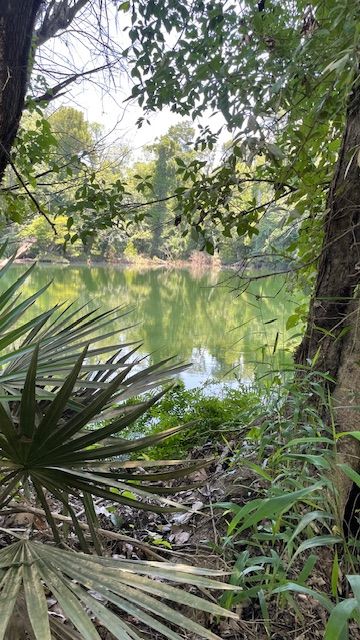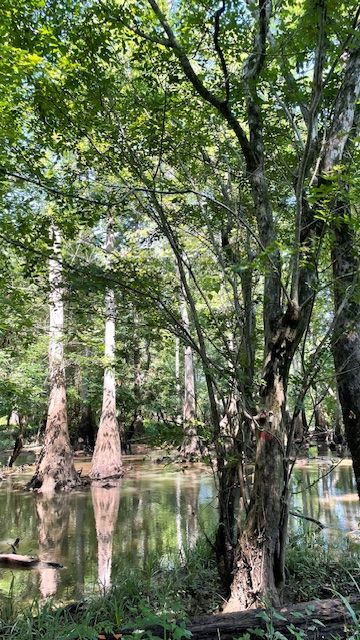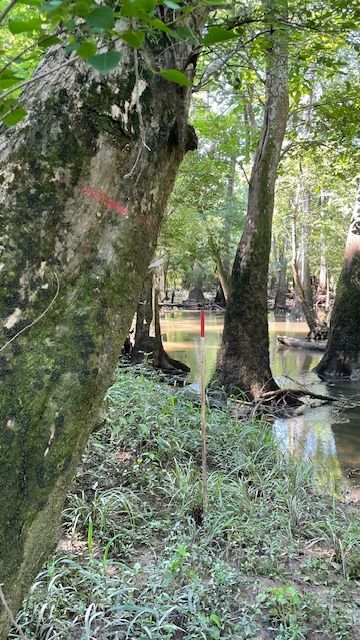I have dealt with content related to carbon credits at multiple times throughout my career at SmartBrief. Each time, I would read an article in depth, often do a Google search and try other methods of picturing exactly what that meant. It all seemed so abstract.
I recently toured a forest carbon project in the Apalachicola River Basin that is managed by Aurora Sustainable Lands, so I can now match up the reality of standing in a floodplain forest that is being used to generate carbon credits with those abstract articles I have read over the years.
The reality is extremely verdant, a little buggy, teeming with wildlife, emanating the feeling of being untouched yet also subject to very specific measurements and auditing processes.
Removing and storing carbon through sustainable forestry to provide carbon credits to businesses is a complex process, but at its heart, it’s a nature-based solution that has the potential to deliver multiple co-benefits such as:
- Stabilizing communities for hurricane resilience
- Supporting biodiversity
- Sequestering carbon from the atmosphere
- Providing recreational opportunities for the community
Simultaneously, carbon plots can fulfill businesses’ needs to voluntarily reduce their emissions or mitigate their climate impact.

A carbon inventory plot within a floodplain forest
This floodplain forest, featuring tupelo trees, is seasonally flooded throughout the year. Their wide bases are well-adapted to being inundated, while their narrower tops help them adjust to fast-moving water and high wind speeds.
These types of floodplain forests are able to hold a lot of water, and the vegetation here slows the rate of flow of that water. Through them, more water can drain down and recharge the aquifers underground. This keeps water from being discharged downstream into downstream communities and has benefits including reducing road erosion.
Measurement of a carbon inventory plot
- The teams measure every single tree on the sample site every single time, typically at the 4.5 foot mark in height
- They aim for measurements that are replicable, accurate and conservative in order not to overstate the amount of carbon
- An audit process follows where senior foresters come out and audit what the consultant foresters did followed by third-party auditors
- The carbon registry does a final check
Discovering biodiversity at Blue Spring
A boat trip on the Apalachicola River took us to Blue Spring, where we could see an example of the biodiversity so critical to sustainable forestry.

The clean, cold water that wells up into the Blue Spring area is an essential component of this high-conservation value forest. Its relative purity creates a specialized habitat. Aurora’s management of an area like this focuses on protecting it and making any changes needed to protect its integrity.
One interesting detail to consider is the role of insects in this ecosystem. The fact that this system maintains water means that it also maintains the habitats ideal for spawning, and that’s directly connected to the timing of nesting for neotropical migrants. It’s all connected, and small changes in the water’s characteristics can have big implications.
Taking a deeper look at biodiversity
John Tracy of the Louisiana State University AgCenter, who has an extensive background in forestry and a specialty in floodplain hydrology and the responses of forest species to stress (specifically along the Apalachicola River), shared in-depth information about the area’s biodiversity. We also learned about the making of tupelo honey, a valued local commodity.
Tracy noted that researchers are now noticing that tree species that prefer drier environments are starting to shift down into these swamp habitats. That means that we’re losing density or numbers of trees that are more stable and more wind resistant in hurricanes, and we’re getting trees that are a little more susceptible to wind damage. Restoration projects within this system try and take the water we do get and return it to these slough systems for longer periods throughout the year, notes Tracy, allowing these tree species to continue to dominate and to perform their services within this system.
Tracy notes that Aurora’s role is helping researchers figure out where they can best place these restoration activities throughout the system. “It’s critical to have a partner like Aurora in a system like this, where they have massive amounts of continuous forest land together,” he says.
Trees Work
There was a lot to take in for a layperson like me in one several-hour tour that encompassed a visit on foot to a carbon inventory plot and a boat tour that visited two areas (one being the Blue Spring, which we toured by foot once we arrived).
There are many pieces to the puzzle of the environment in general and the role of carbon credits in particular. The government has a role. We as individual citizens have a role. Private businesses have a role.
Throughout the day, I learned about what one of those private businesses, Aurora Sustainable Lands, is doing along the Apalachicola River.
The two words that stuck with me most as we finished our day are “trees work.”
I have a better appreciation now for what “trees work” means … even if what I see is a tree just “existing” as water flows around it and a variety of species make their homes from it or gain sustenance from it. I have a more comprehensive understanding.
When I read that “one carbon credit unit represents a metric ton of carbon dioxide pulled from the atmosphere,” I still have a little trouble getting my head around how that would look.
However, I have a clearer picture of how carbon credits are generated and why than can make a difference.
It all boils down to the fact that — managed appropriately — “trees work.”
Disclosure: All thoughts in this post are my own; this is not a sponsored post. I am grateful to Aurora Sustainable Lands for the invitation to tour the area, the access to nonpublic areas and the expertise shared by the subject matter experts present.

Wife of one, Mom of two, Friend of many. My pronouns are she/her/hers.



I’m so thankful for the people who are trying to help this earth, instead of destroy it. Trees are just amazing. Sounds like an interesting tour.
I agree! I had to stop writing at some point, but there’s so much more. And when I was listening back to my recording of the people speaking, there were so many nature sounds. I feel like I need more of that (which is a different topic from carbon forestry)!
Paula…HI! Been missing you. This is a great piece and so important for our LIFE, COUNTRY, and FUTURE. Nature is a gift that we so often take for granted. Even my garden and my care of it gives me hope that nature loves what I do and realizes that I am grateful. Thanks for your post.
Hi Beth. Yes, sorry to be so out of the loop! Thanks for stopping by. You are so right about nature. Standing in this ancient place surrounded by greenery, water, animals (and yes bugs) was a needed reminder.
Nature is and always has been my happy place. It’s nice to do our part with carbon credits. Hoping that larger entities will do more now and into the future.
I hope so too. I really didn’t get into it in the blog, but Aurora recently contracted with Microsoft for a carbon credit arrangement, which is pretty cool!!